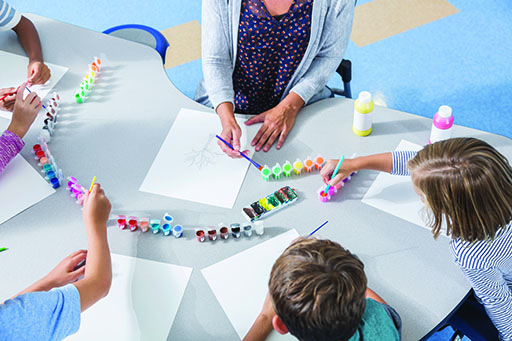4.2 Observing and listening: case study 2
A good way to learn a language and to practise using it is by doing something with others: cooking, walking, building, painting, drawing, sewing, craft work, learning the rules of a game or the words of a song, shopping, role play or storytelling. In your home or your community, you may be responsible for organising such activities for children, where they will have opportunities to talk with you and with each other.
Activity _unit2.4.2 Activity 3 Observing children who use English as an additional language
In the following transcript, a teacher and Year 6 children (ages 10–11) are painting farm animals and farm scenery together. The four children (two boys and two girls) are recent arrivals from Portugal and are at the early stages of learning and using English in school. Note down your observations.
Boy 1: Was there paint in the olden days?
Teacher: Yes, but it was always made from natural materials.
Girl 1: My mum has farm in Portugal, she has one pig and the floor is all dirty.
Boy 2: When I went to Portugal, we had a pig, I was holding the legs, the rope broke. I had to throw the knife at him!
Teacher: What! You held a pig? Why were you doing that?
Boy 2: To kill him.
Teacher: Oh I don’t know if I could do that!
Girl 2: My Nan has a donkey on her farm, behind her house she grows grapes. Everyone knows my Nan and me! One morning I got up early and picked grapes and corn.
Teacher: I love grapes.
Boy 1: My Nan has a horse. Do you know why?
Teacher: No, why?
Boy 1: To put with the cart [mimes a horse and cart, shaking the reins].
Teacher: And do you think you prefer the city [here] or the country like Portugal?
Boy 1: I like the country.
Discussion
In this conversation, the adult is not directing the children and talking ‘at’ them but is working alongside and talking with them. The activity itself (painting farm animals) sustains a discussion where children talk at length about something that is of direct interest to them; they are not answering ‘closed’ (‘yes’ or ‘no’) questions, and so they have opportunities to produce and use spoken English in a meaningful, relevant way. The collaborative activity creates a space where the children and the adult can ask each other questions and learn about one another. Notice that Boy 1 asks about whether there was paint in the ‘olden’ days. He learned that English word in classroom storytelling sessions.
The teacher in this transcript later said:
Talk is so directed in the classroom. It’s only when you talk with them [children] that you find out where they are. Otherwise you never know where they are. It’s by listening to them that you find out how they learn, what they need to know.
When you observe and listen, you can learn specific information based directly on what children say or do. For example, from the transcript you know that the mother of Girl 1 has a farm in Portugal.
You can also infer, or make educated guesses, based on your observations. For example, reading the transcript, you could infer that all four children have experiences of rural life.
Next, you’ll learn about two important aspects of adult work in primary schools: safeguarding and ethical conduct.

